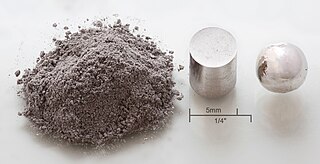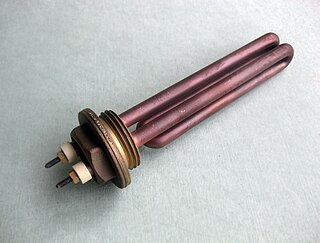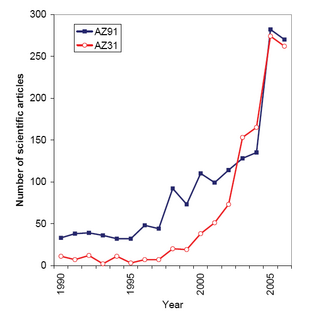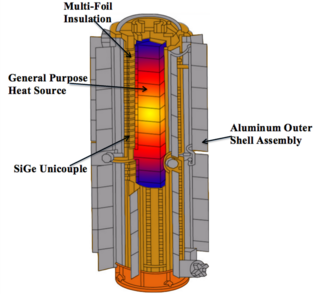Related Research Articles

Magnesium is a chemical element; it has symbol Mg and atomic number 12. It is a shiny gray metal having a low density, low melting point and high chemical reactivity. Like the other alkaline earth metals it occurs naturally only in combination with other elements and it almost always has an oxidation state of +2. It reacts readily with air to form a thin passivation coating of magnesium oxide that inhibits further corrosion of the metal. The free metal burns with a brilliant-white light. The metal is obtained mainly by electrolysis of magnesium salts obtained from brine. It is less dense than aluminium and is used primarily as a component in strong and lightweight alloys that contain aluminium.

Nickel is a chemical element; it has symbol Ni and atomic number 28. It is a silvery-white lustrous metal with a slight golden tinge. Nickel is a hard and ductile transition metal. Pure nickel is chemically reactive, but large pieces are slow to react with air under standard conditions because a passivation layer of nickel oxide forms on the surface that prevents further corrosion. Even so, pure native nickel is found in Earth's crust only in tiny amounts, usually in ultramafic rocks, and in the interiors of larger nickel–iron meteorites that were not exposed to oxygen when outside Earth's atmosphere.

Rhodium is a chemical element; it has symbol Rh and atomic number 45. It is a very rare, silvery-white, hard, corrosion-resistant transition metal. It is a noble metal and a member of the platinum group. It has only one naturally occurring isotope, which is 103Rh. Naturally occurring rhodium is usually found as a free metal or as an alloy with similar metals and rarely as a chemical compound in minerals such as bowieite and rhodplumsite. It is one of the rarest and most valuable precious metals.

Stainless steel, also known as inox, corrosion-resistant steel (CRES) and rustless steel, is an alloy of iron that is resistant to rusting and corrosion. It contains iron with chromium and other elements such as molybdenum, carbon, nickel and nitrogen depending on its specific use and cost. Stainless steel's resistance to corrosion results from the 10.5%, or more, chromium content which forms a passive film that can protect the material and self-heal in the presence of oxygen.

A thermocouple, also known as a "thermoelectrical thermometer", is an electrical device consisting of two dissimilar electrical conductors forming an electrical junction. A thermocouple produces a temperature-dependent voltage as a result of the Seebeck effect, and this voltage can be interpreted to measure temperature. Thermocouples are widely used as temperature sensors.

Cupronickel or copper–nickel (CuNi) is an alloy of copper with nickel, usually along with small quantities of other elements added for strength, such as iron and manganese. The copper content typically varies from 60 to 90 percent.
Resistance thermometers, also called resistance temperature detectors (RTDs), are sensors used to measure temperature. Many RTD elements consist of a length of fine wire wrapped around a heat-resistant ceramic or glass core but other constructions are also used. The RTD wire is a pure material, typically platinum (Pt), nickel (Ni), or copper (Cu). The material has an accurate resistance/temperature relationship which is used to provide an indication of temperature. As RTD elements are fragile, they are often housed in protective probes.

A heating element is a device used for conversion of electric energy into heat, consisting of a heating resistor and accessories. Heat is generated by the passage of electric current through a resistor through a process known as Joule Heating. Heating elements are used in household appliances, industrial equipment, and scientific instruments enabling them to perform tasks such as cooking, warming, or maintaining specific temperatures higher than the ambient.
Ferroalloy refers to various alloys of iron with a high proportion of one or more other elements such as manganese (Mn), aluminium (Al), or silicon (Si). They are used in the production of steels and alloys. The alloys impart distinctive qualities to steel and cast iron or serve important functions during production and are, therefore, closely associated with the iron and steel industry, the leading consumer of ferroalloys. The leading producers of ferroalloys in 2014 were China, South Africa, India, Russia and Kazakhstan, which accounted for 84% of the world production. World production of ferroalloys was estimated as 52.8 million tonnes in 2015.
Elektron is the registered trademark of a wide range of magnesium alloys manufactured by a British company, Magnesium Elektron Limited.
Nisil is an alloy of nickel and silicon with traces of Mg, which is non-magnetic.
Alumel is an alloy consisting of approximately 95% nickel, 2% aluminium, 2% manganese, and 1% silicon. This magnetic alloy is used to make the negative conductors of ANSI Type K (chromel-alumel) thermocouples and thermocouple extension wire. Alumel is a registered trademark of Concept Alloys, Inc.
Chromel is an alloy made of approximately 90% nickel and 10% chromium by weight that is used to make the positive conductors of ANSI Type E (chromel-constantan) and K (chromel-alumel) thermocouples. It can be used at temperatures up to 1,100 °C (2,010 °F) in oxidizing atmospheres. Chromel is a registered trademark of Concept Alloys, Inc.

Magnesium alloys are mixtures of magnesium with other metals, often aluminium, zinc, manganese, silicon, copper, rare earths and zirconium. Magnesium alloys have a hexagonal lattice structure, which affects the fundamental properties of these alloys. Plastic deformation of the hexagonal lattice is more complicated than in cubic latticed metals like aluminium, copper and steel; therefore, magnesium alloys are typically used as cast alloys, but research of wrought alloys has been more extensive since 2003. Cast magnesium alloys are used for many components of modern automobiles and have been used in some high-performance vehicles; die-cast magnesium is also used for camera bodies and components in lenses.

The SAE steel grades system is a standard alloy numbering system for steel grades maintained by SAE International.

An aluminium alloy (UK/IUPAC) or aluminum alloy is an alloy in which aluminium (Al) is the predominant metal. The typical alloying elements are copper, magnesium, manganese, silicon, tin, nickel and zinc. There are two principal classifications, namely casting alloys and wrought alloys, both of which are further subdivided into the categories heat-treatable and non-heat-treatable. About 85% of aluminium is used for wrought products, for example rolled plate, foils and extrusions. Cast aluminium alloys yield cost-effective products due to the low melting point, although they generally have lower tensile strengths than wrought alloys. The most important cast aluminium alloy system is Al–Si, where the high levels of silicon (4–13%) contribute to give good casting characteristics. Aluminium alloys are widely used in engineering structures and components where light weight or corrosion resistance is required.
The coinage metals comprise those metallic chemical elements and alloys which have been used to mint coins. Historically, most coinage metals are from the three nonradioactive members of group 11 of the periodic table: copper, silver and gold. Copper is usually augmented with tin or other metals to form bronze. Gold, silver and bronze or copper were the principal coinage metals of the ancient world, the medieval period and into the late modern period when the diversity of coinage metals increased. Coins are often made from more than one metal, either using alloys, coatings (cladding/plating) or bimetallic configurations. While coins are primarily made from metal, some non-metallic materials have also been used.
Lo-Ex is an aluminium alloy with a very small thermal expansion co-efficient. It contains approximately 14 per cent silicon, 2 per cent nickel, and 1 per cent each of copper and magnesium.

Silicon-germanium (SiGe) thermoelectrics have been used for converting heat into electrical power in spacecraft designed for deep-space NASA missions since 1976. This material is used in the radioisotope thermoelectric generators (RTGs) that power Voyager 1, Voyager 2, Galileo, Ulysses, Cassini, and New Horizons spacecraft. SiGe thermoelectric material converts enough radiated heat into electrical power to fully meet the power demands of each spacecraft. The properties of the material and the remaining components of the RTG contribute towards the efficiency of this thermoelectric conversion.
References
- ↑ "Nicrosil alloy". Archived from the original on 2007-12-25. Retrieved 2007-10-31.
- 1 2 "Type N thermocouples" (PDF). Archived from the original (PDF) on 2006-10-15. Retrieved 2007-10-31.